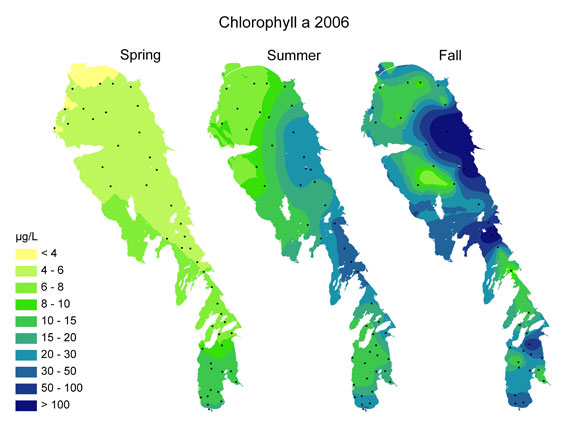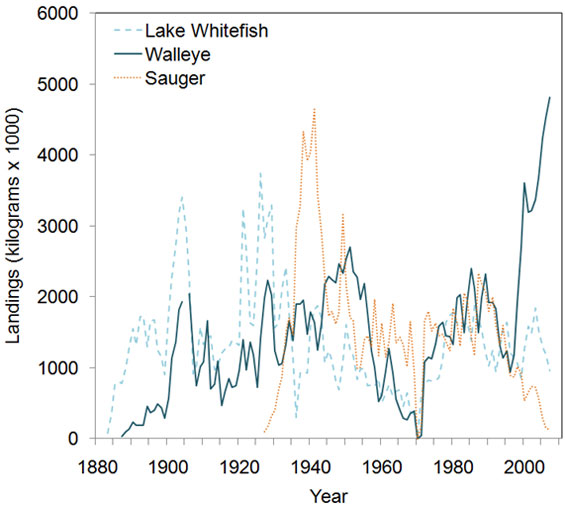
Seasonal chlorophyll a in Lake Winnipeg in 2006
Data source: Manitoba Water Stewardship
(click to view larger image)
| Previous | Table of Contents | Next |
Phytoplankton are useful indicators of nutrient enrichment in aquatic ecosystems because of their relatively short life cycles that are integrative of water chemistry conditions. An indication of the recent nutrient enrichment of Lake Winnipeg has been the development of large blooms of cyanobacteria during the summer months. Noticeable changes have also occurred during the ice cover season with diatoms coating fishers’ nets, making the nets more visible to fish.

Average annual chlorophyll a concentrations, which are a common measure of the amount of algae, were almost two times higher in the north basin (14.4 µg/L) compared to the south basin (8 µg/L) from 1999 to 2007. In the fall of 2006 and 2007, prolific blooms were observed along the eastern shoreline of the north basin and through parts of the narrows where light and nutrients were likely favourable for phytoplankton growth. Algal blooms in the south basin of Lake Winnipeg were apparent in the fall of 2006 but were not observed the following year. In the turbid south basin of Lake Winnipeg, phytoplankton biomass is often constrained by light, which may help to explain inter-annual variability in algal bloom formation. From 1999 to 2007, both phytoplankton biomass and chlorophyll a concentrations were highest in 2006 and may have been partly attributed to the high nutrient loads in 2005 and above-average air temperatures in 2006.
A large proportion (>80%) of the total phytoplankton biomass in Lake Winnipeg during the ice-free season from 1999 to 2007 was represented by blue-green algae or cyanobacteria (Aphanizomenon, Anabaena, Microcystis) and diatoms (Aulacoseira, Stephanodiscus). Cyanobacteria capable of nitrogen fixation (Aphanizomenon, Anabaena) were dominant during the summer and fall in most years from 1999 to 2007 in Lake Winnipeg. However, in certain years, large blooms of non-nitrogen-fixing cyanobacteria also comprised a significant fraction of the total cyanobacteria biomass in Lake Winnipeg. Large blooms of Microcystis contributed to increases in non-nitrogen-fixing cyanobacteria biomass and occurred primarily in the south basin.

Benthic macroinvertebrates are organisms that inhabit the bottom sediments of lakes for at least part of their life cycle. Examples include freshwater shrimp, insect larvae, midges and worms. Benthic macroinvertebrates play a critical role in the aquatic food web in lakes, serving as a major component of the diet of many fish.
Benthic organisms in Lake Winnipeg as a whole have undergone substantial increases in density in recent decades. Mean density in 2002 was more than triple that in 1969, particularly in the north basin of Lake Winnipeg. Both midges and aquatic worms comprised a substantial component of the benthic macroinvertebrate community. The abundance and types of benthic macroinvertebrates may respond both directly and indirectly to the increased availability of food resources as a consequence of nutrient enrichment. For example, aquatic worms, which tend to dominate sediments in stressed waters, increased markedly in abundance from 1969 to 2002 in the north basin of Lake Winnipeg, which may be a response to increased nutrient loading to Lake Winnipeg in recent years.

Lake Winnipeg has long supported important domestic, recreational and commercial fisheries. The commercial fishery began as a gill net fishery for Lake Whitefish in the late 1800s. Lake Whitefish decreased in the 1930s, and Sauger and Walleye began to dominate the commercial fishery. Walleye harvest fluctuated over the decades, and increased until the mid-1980s, then declined in the mid-1990s. Since the mid-1990s, Walleye harvest has increased and is nearly double any historical Walleye harvest for Lake Winnipeg. Increases in total phosphorus, chlorophyll a and zooplankton densities in recent years may help to explain the increased Walleye harvest. Potential future changes in climate may bring about further change to Lake Winnipeg fishes, with projected increases in the length of the growing season and warmer water temperatures potentially having detrimental effects on some coldwater species.
Since 2002, 25 prey fish species were collected in fish trawl tows from the MV Namao. Emerald Shiner, Rainbow Smelt and Cisco were the dominant species by mass in all years. Biomass of Emerald Shiner and Cisco was greater in the south basin and narrows compared to the north basin. Non-native Rainbow Smelt are now the dominant prey fish species in the north basin of the lake. It is unknown to what extent Rainbow Smelt have affected the food web and Walleye production in Lake Winnipeg. Adult Rainbow Smelt may be predators of zooplankton and early year classes of native fish species, and may compete with native fish species for food resources. A recent food web isotope model indicated that Rainbow Smelt occupied the lower forage fish trophic position that is typically used by Walleye. Baseline isotopic studies on Lake Winnipeg have provided information that can be used to readily define sources of water and attendant nutrient inputs to the Lake Winnipeg food web. Trace metal concentrations in fish, with an emphasis on mercury, will be examined to see how food web isotope patterns can inform the transport of these contaminants from fish to birds.
| Previous | Table of Contents | Next |